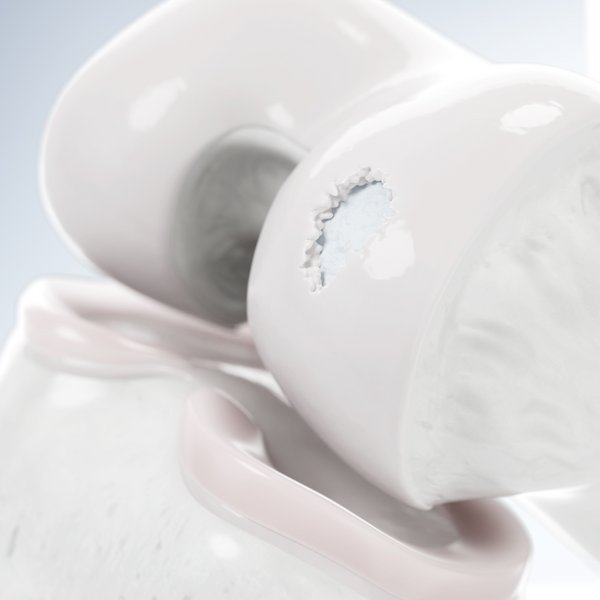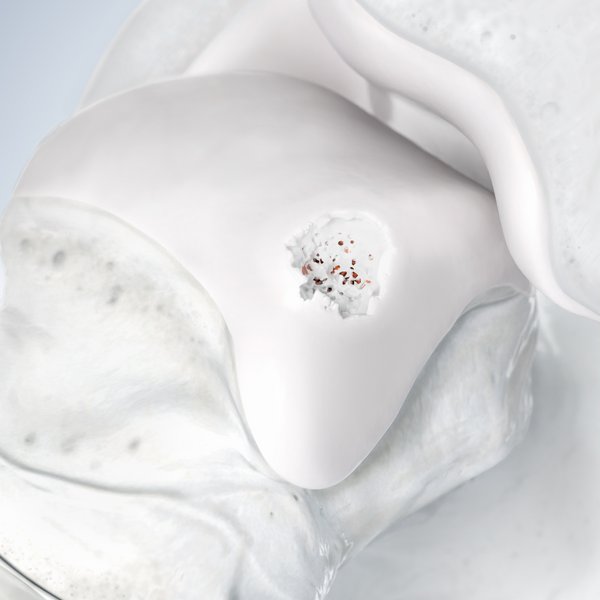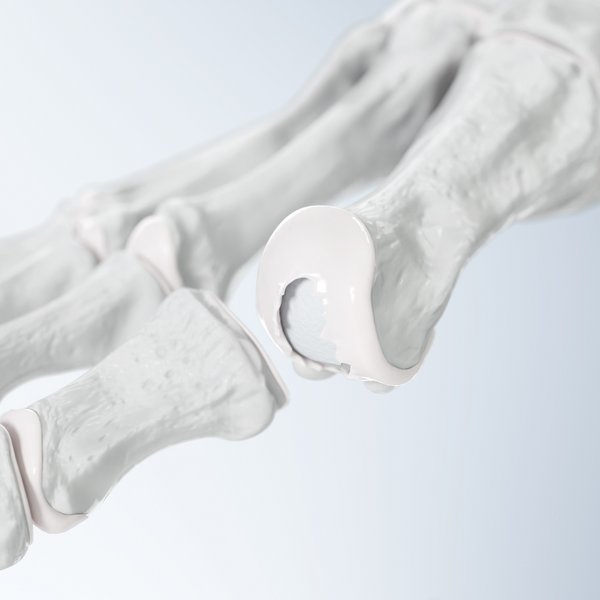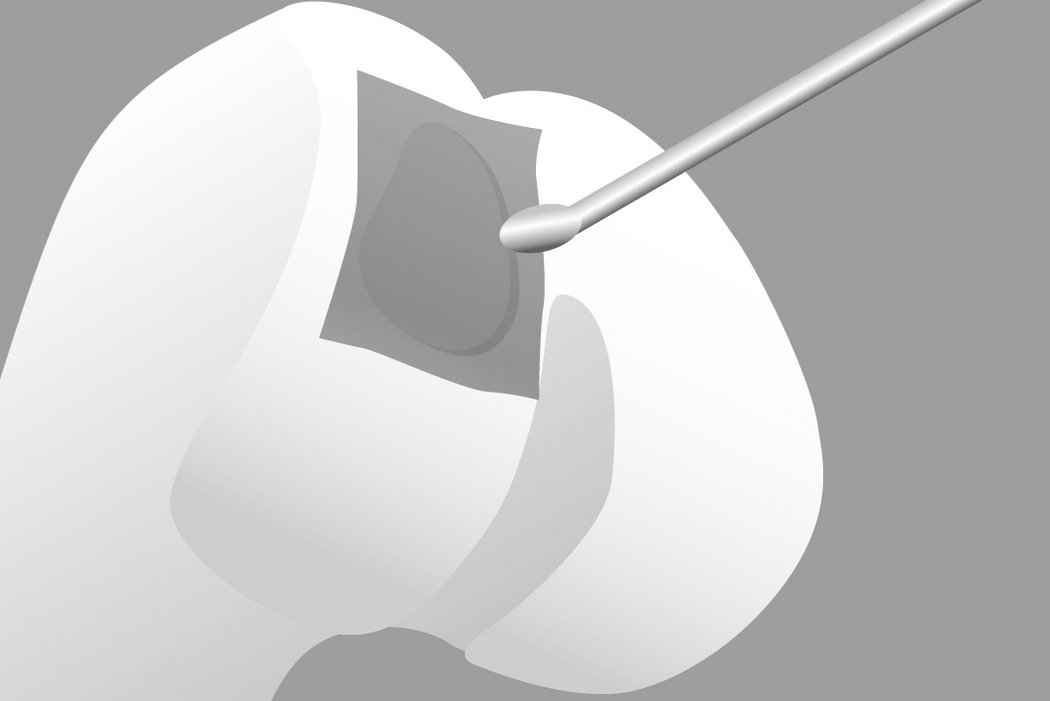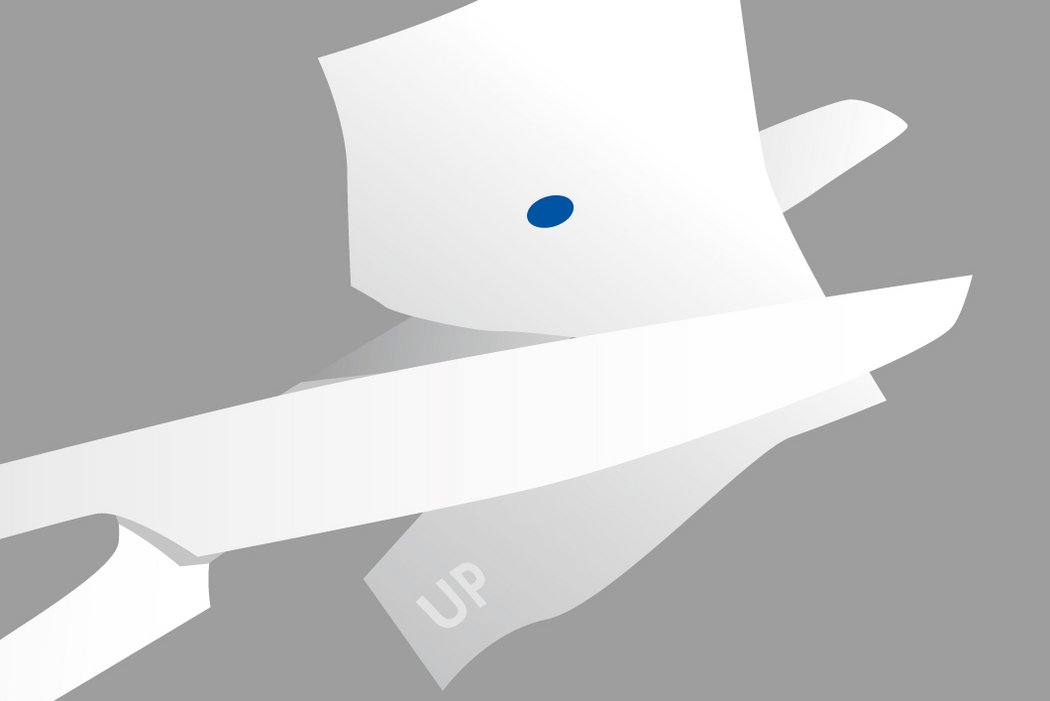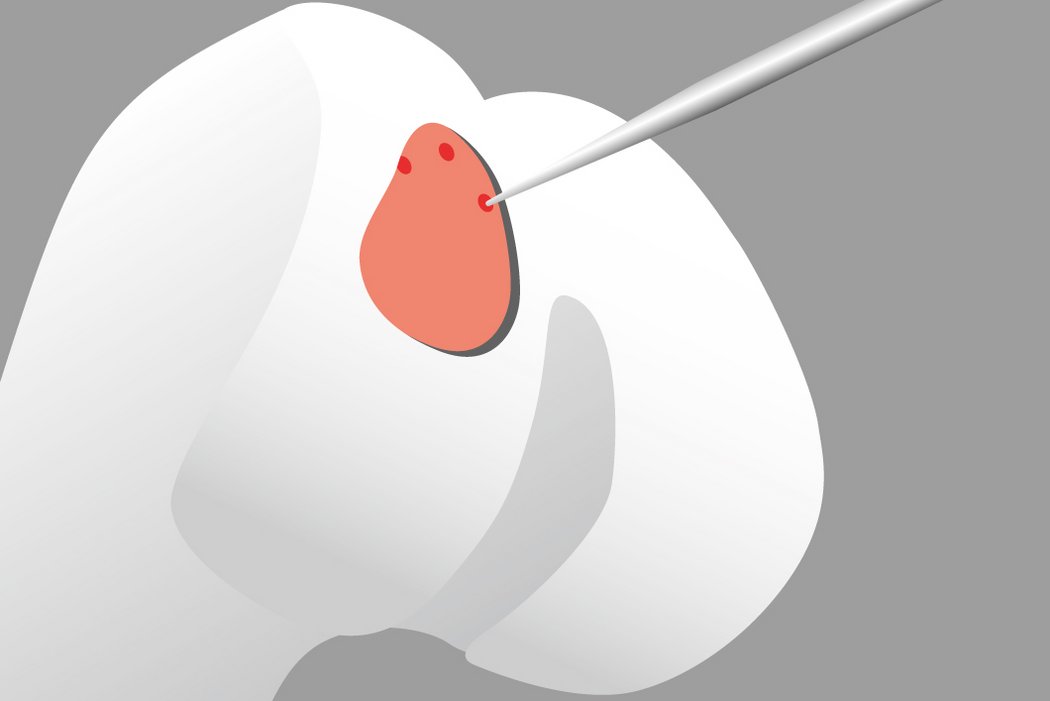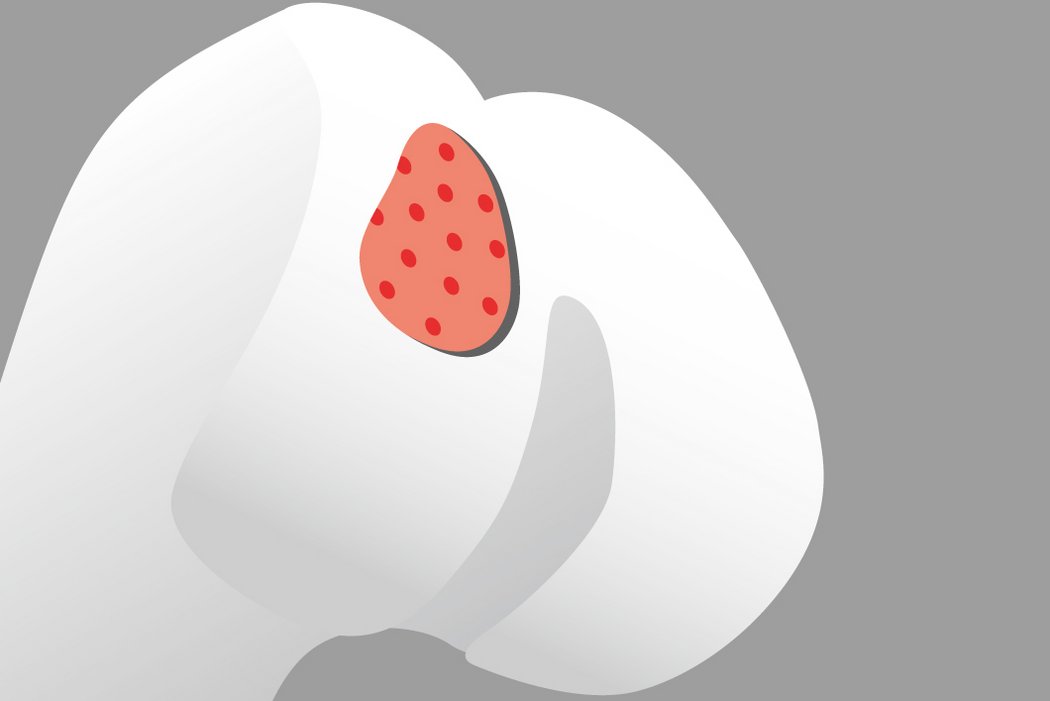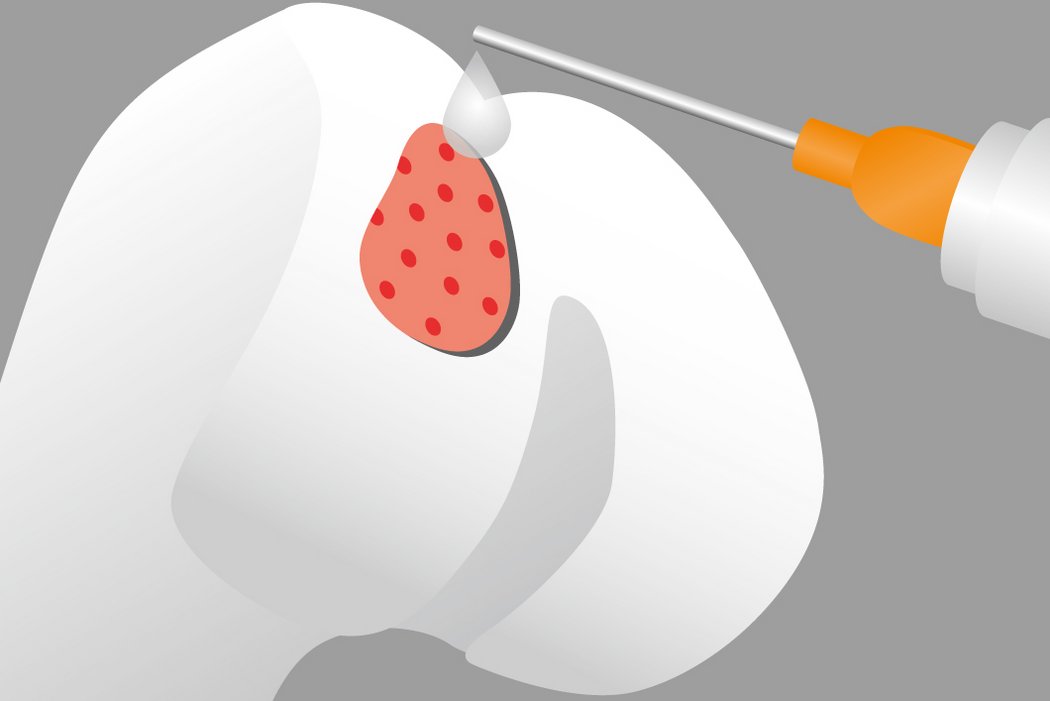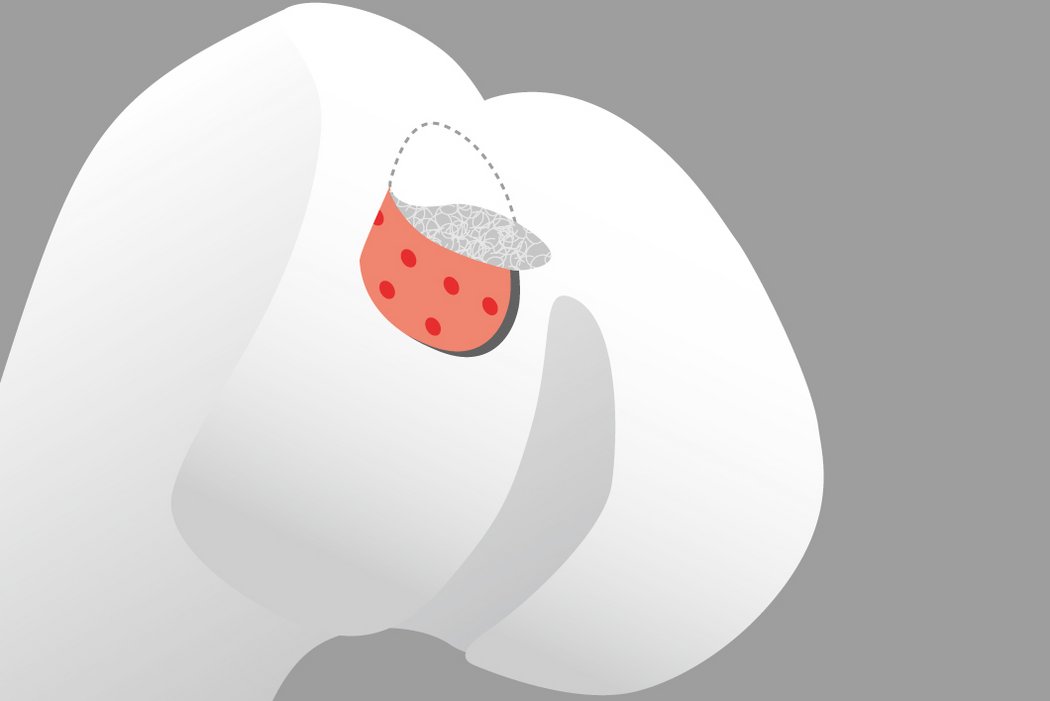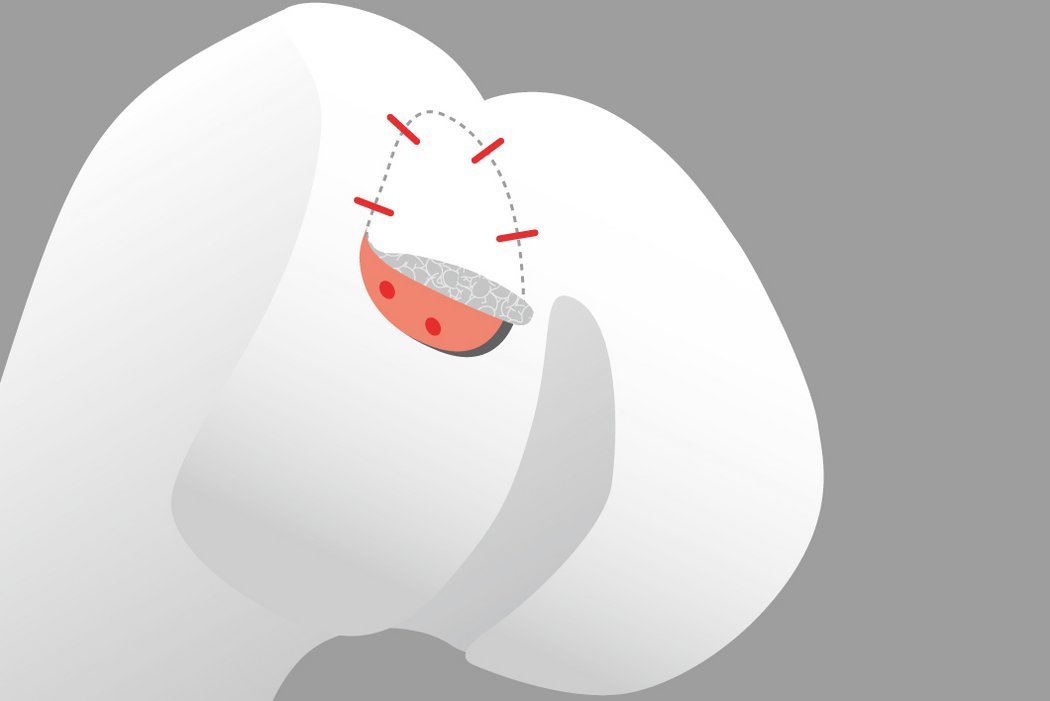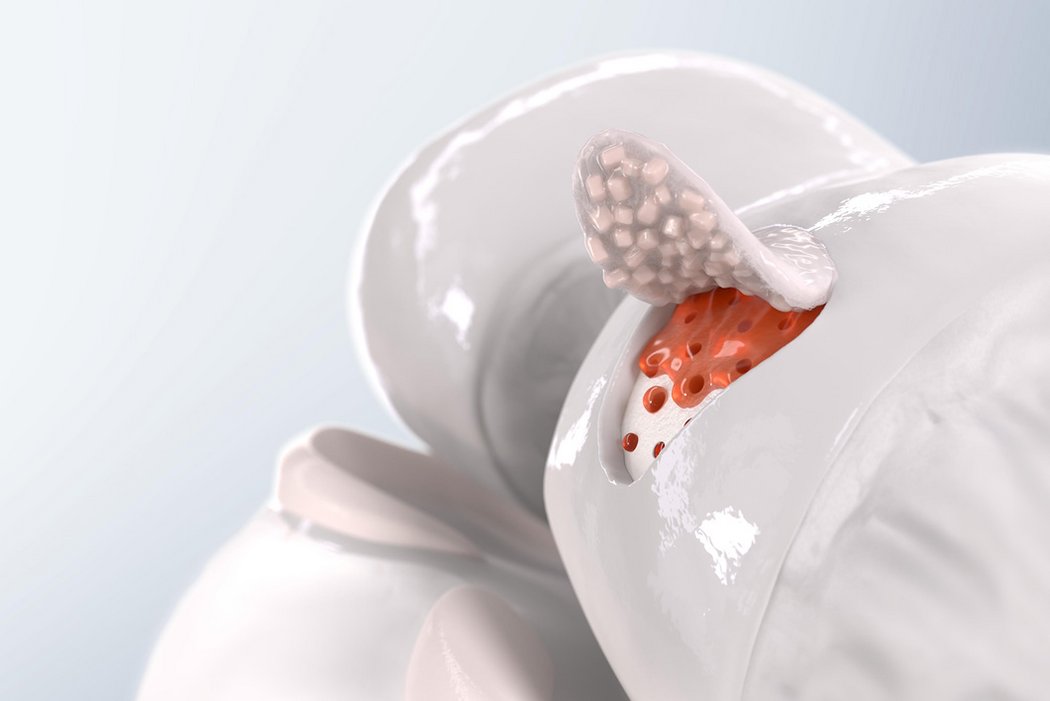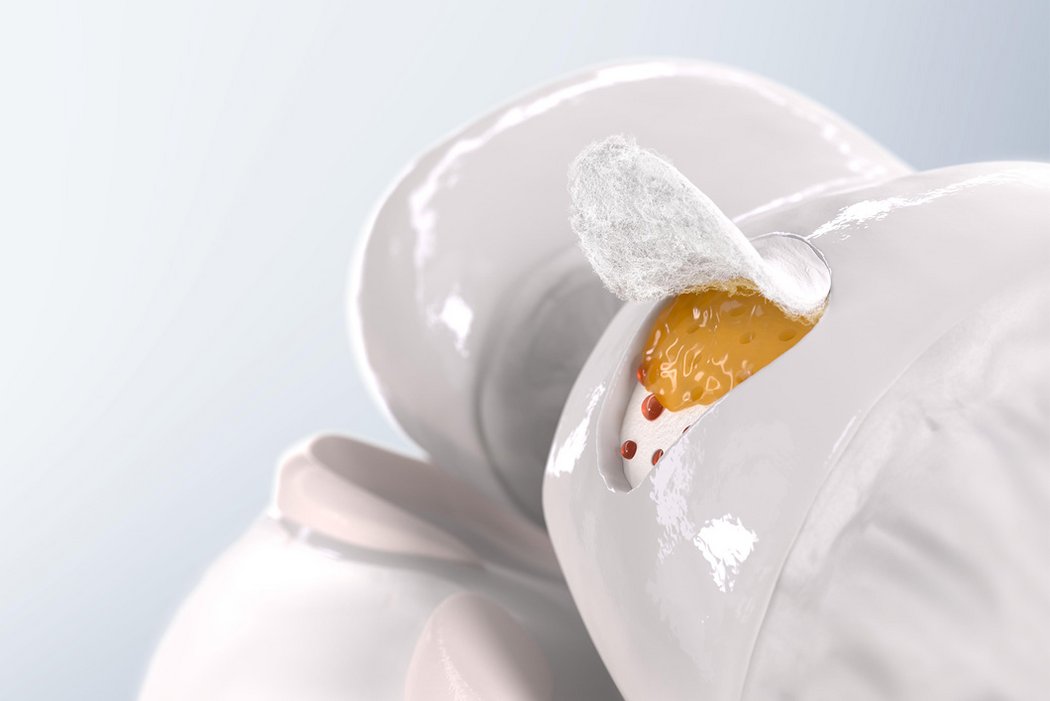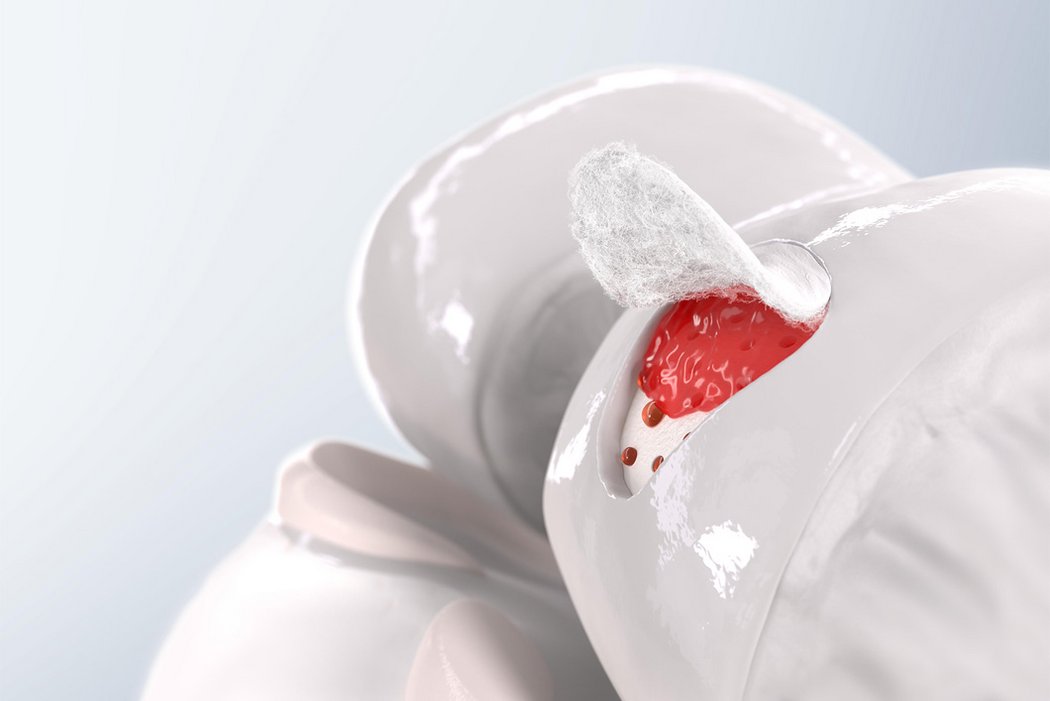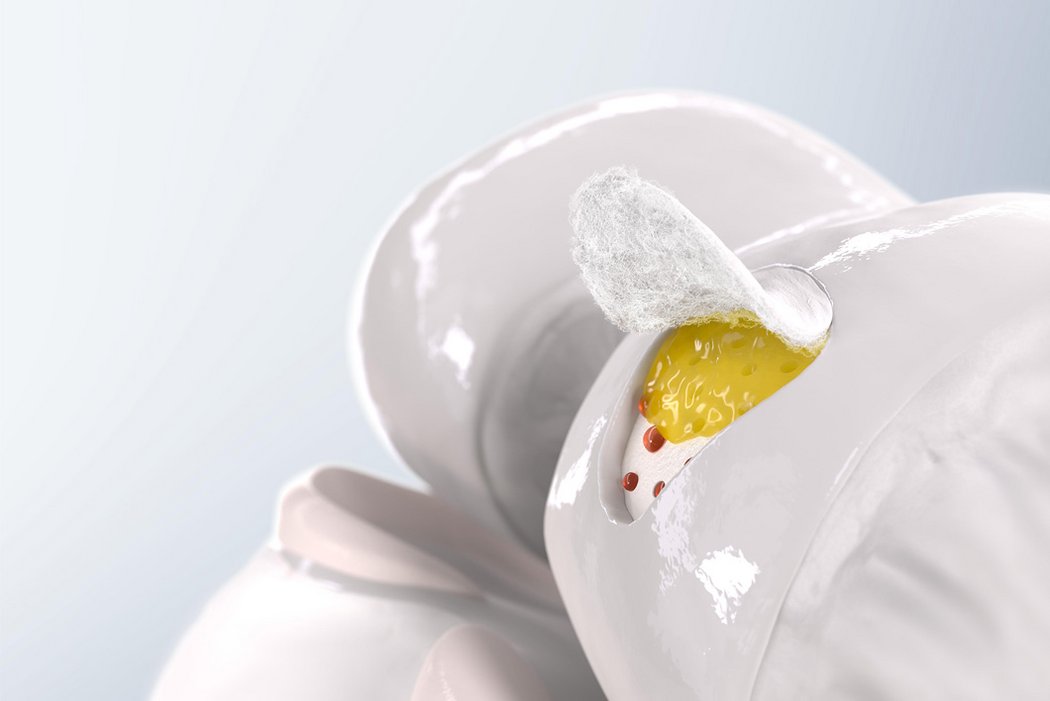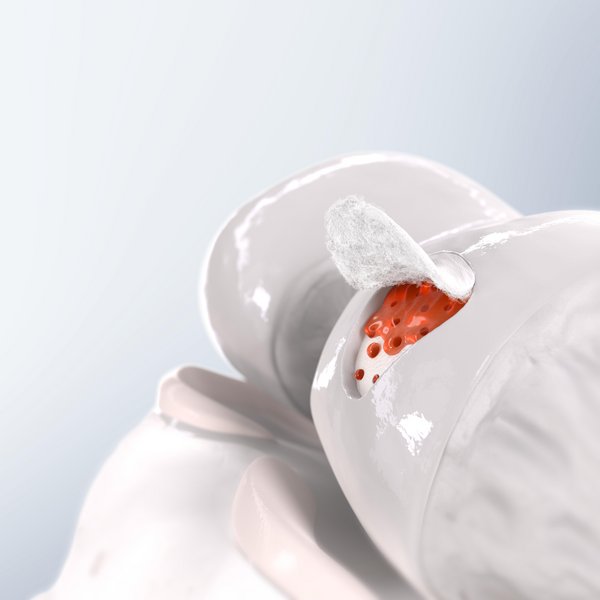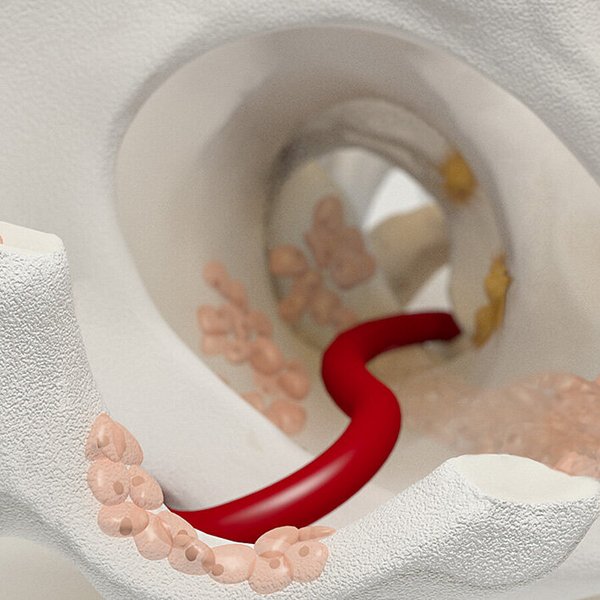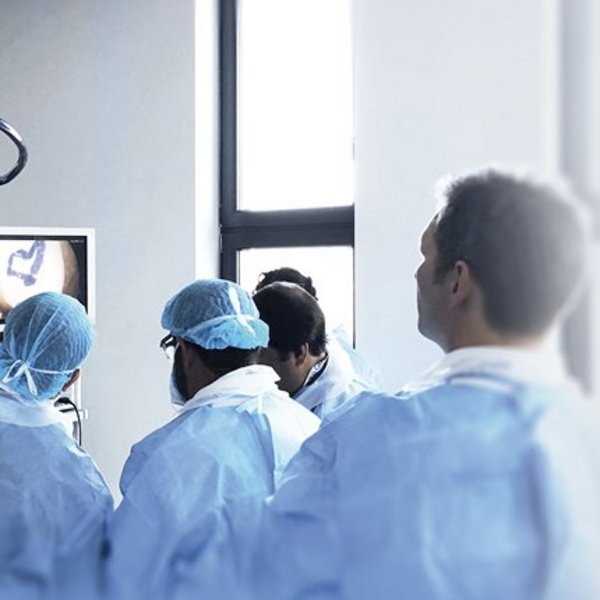AMIC® Chondro-Gide®
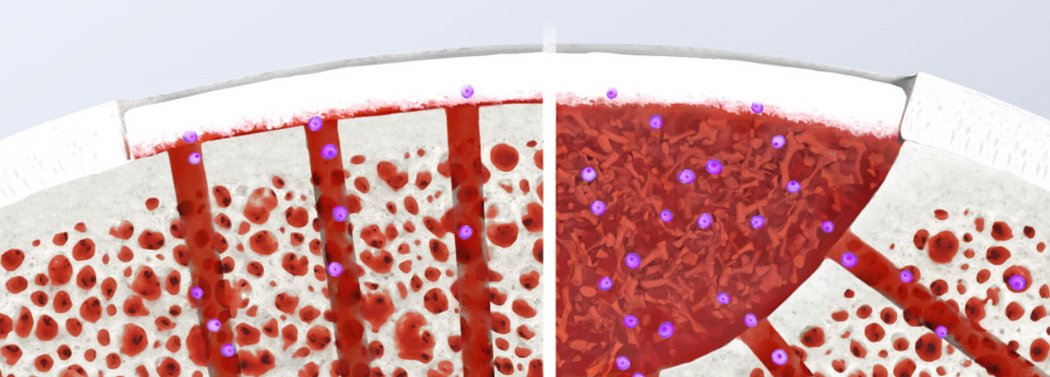
AMIC® Chondro-Gide® est une procédure mini-invasive en une seule étape pouvant être réalisée par chirurgie en mini-open ou par arthroscopie. Élaborée par Geistlich Surgery avec l’aide d’éminents chirurgiens européens, cette technique est d’une efficacité avérée pour la régénération des lésions chondrales ou ostéochondrales du genou, du talus et de la hanche.1,2,3
Bénéfices de la technique AMIC® avec Chondro-Gide®
Avec la technique « mini-open » comme avec l’arthroscopie, l’avantage exclusif de la procédure AMIC® Chondro-Gide® réside dans le fait qu’elle exploite la capacité de l’organisme à s’autorégénérer. Le cartilage endommagé est enlevé, puis on utilise les techniques de stimulation de la moelle osseuse pour faire migrer les cellules de régénération vers la région lésée.
La membrane recouvre la lésion et forme un environnement protecteur pour les cellules et pour le caillot fibrineux. Dans le même temps, elle fait office de toiture pour la « chambre biologique » qui se forme dans la lésion. Le collagène biocompatible offre un environnement favorable à la prolifération des cellules et se fait remplacer petit à petit par un nouveau tissu cartilagineux.5
Réferences
- VOLZ, M., et al. A randomized controlled trial demonstrating sustained benefit of Autologous Matrix-Induced Chondrogenesis over microfracture at five years. Int Orthop, Apr 2017, 41(4), 797-804) (Clinical study)
- JANELLI, E, et al. Arthroscopic treatment of chondral defects (Clinical study); in the hip: AMIC®, MACI, microfragmented adipose tissue transplantation (MATT) and other options. SICOT J, 2017, 3(43). (Clinical study)
- Geistlich Pharma AG data on file (Bench test)
- GILLE, J., et al. Cell-Laden and Cell-Free Matrix-Induced-Chondrogenesis versus Microfracture for the Treatment of Articular Cartilage Defects: A Histological and Biomechanical Study in Sheep. Cartilage OnlineFirst, January 7, 2010, doi:10.1177/1947603509358721 (Pre-clinical study)
- STEADMAN, J.R., Microfracture Technique for Full-Thickness Chondral Defects: Technique and Clinical Results. Operative Techniques in Orthopaedics. 1997. 7(4), 300-304. (Clinical study)
- STEINWACHS, M.R., et al. Matrix-associated chondroplasty: a novel platelet-rich plasma and concentrated nucleated bone marrow cell-enhanced cartilage restoration technique, Arthroscopy Techniques, 2014, (3) 2, pp e279-e282 (Clinical study)
- RICHTER, M., et al. Matrix-associated stem cell transplantation (MAST) in chondral lesions at the ankle as part of a complex surgical approach- 5-year-follow-up in 100 patients, Foot and Ankle Surgery, Volume 25, Issue 3, June 2019, Pages 264-271 (Clinical study)
- RICHTER, M. et al. Matrix-associated stem cell transplantation (MAST) versus autologous matrix induced chondrogenesis plus peripheral blood concentrate (AMIC+PBC) in chondral defects of the first metatarsophalangeal joint – A clinical cohort analysis." Fuß & Sprunggelenk, 2020, 18(3): 217-226. (Clinical study)
- DE GIROLAMO, L., et al., Autologous Matrix-Induced Chondrogenesis (AMIC) and AMIC Enhanced by Autologous Concentrated Bone Marrow Aspirate (BMAC) Allow for Stable Clinical and Functional Improvements at up to 9 Years Follow-Up: Results from a Randomized Controlled Study. Journal of Clinical Medicine. 2019. Vol. 8, no. 3, p. 392. (Clinical Study).
- GOBBI, A., et al. One-Step Cartilage Repair with Bone Marrow Aspirate Concentrated Cells and Collagen Matrix in Full-Thickness Knee Cartilage Lesions: Results at 2-Year Follow-up. Cartilage, 2011, 2(3): 286-299. (Clinical study)
- GOBBI, A., et al., One-step surgery with multipotent stem cells for the treatment of large full-thickness chondral defects of the knee. Am J Sports Med, 2011 42(3): 648-657. (clinical study)
- MASSEN, F.K., et al. One-Step Autologous Minced Cartilage Procedure for the Treatment of Knee Joint Chondral and Osteochondral Lesions: A Series of 27 Patients With 2-Year Follow-up. Orthop J Sports Med 2019 Jun 13;7(6) (Clinical study)
- SCIARETTA, F.V., One-Step Biological Resurfacing of Osteochondral Defects of the Patella, Novel Surgical Technique, Osteochondral Defects, Sphera Medical Journal, AlphaSigmaGroup, 2016
Utilisation de Chondro-Gide® dans les différentes articulations
Développé pour favoriser la régénération : AMIC® Chondro-Gide®
Réferences:
- VOLZ, M., et al. A randomized controlled trial demonstrating sustained benefit of Autologous Matrix-Induced Chondrogenesis over microfracture at five years. Int Orthop, Apr 2017, 41(4), 797-804) (Clinical study)
- JANELLI, E, et al. Arthroscopic treatment of chondral defects (Clinical study); in the hip: AMIC®, MACI, microfragmented adipose tissue transplantation (MATT) and other options. SICOT J, 2017, 3(43). (Clinical study)
- Geistlich Pharma AG data on file (Bench test)
- GILLE, J., et al. Cell-Laden and Cell-Free Matrix-Induced-Chondrogenesis versus Microfracture for the Treatment of Articular Cartilage Defects: A Histological and Biomechanical Study in Sheep. Cartilage OnlineFirst, January 7, 2010, doi:10.1177/1947603509358721 (Pre-clinical study)
- STEADMAN, J.R., Microfracture Technique for Full-Thickness Chondral Defects: Technique and Clinical Results. Operative Techniques in Orthopaedics. 1997. 7(4), 300-304. (Clinical study)
- STEINWACHS, M.R., et al. Matrix-associated chondroplasty: a novel platelet-rich plasma and concentrated nucleated bone marrow cell-enhanced cartilage restoration technique, Arthroscopy Techniques, 2014, (3) 2, pp e279-e282 (Clinical study)
- RICHTER, M., et al. Matrix-associated stem cell transplantation (MAST) in chondral lesions at the ankle as part of a complex surgical approach- 5-year-follow-up in 100 patients, Foot and Ankle Surgery, Volume 25, Issue 3, June 2019, Pages 264-271 (Clinical study)
- RICHTER, M. et al. Matrix-associated stem cell transplantation (MAST) versus autologous matrix induced chondrogenesis plus peripheral blood concentrate (AMIC+PBC) in chondral defects of the first metatarsophalangeal joint – A clinical cohort analysis." Fuß & Sprunggelenk, 2020, 18(3): 217-226. (Clinical study)
- DE GIROLAMO, L., et al., Autologous Matrix-Induced Chondrogenesis (AMIC) and AMIC Enhanced by Autologous Concentrated Bone Marrow Aspirate (BMAC) Allow for Stable Clinical and Functional Improvements at up to 9 Years Follow-Up: Results from a Randomized Controlled Study. Journal of Clinical Medicine. 2019. Vol. 8, no. 3, p. 392. (Clinical Study).
- GOBBI, A., et al. One-Step Cartilage Repair with Bone Marrow Aspirate Concentrated Cells and Collagen Matrix in Full-Thickness Knee Cartilage Lesions: Results at 2-Year Follow-up. Cartilage, 2011, 2(3): 286-299. (Clinical study)
- GOBBI, A., et al., One-step surgery with multipotent stem cells for the treatment of large full-thickness chondral defects of the knee. Am J Sports Med, 2011 42(3): 648-657. (clinical study)
- MASSEN, F.K., et al. One-Step Autologous Minced Cartilage Procedure for the Treatment of Knee Joint Chondral and Osteochondral Lesions: A Series of 27 Patients With 2-Year Follow-up. Orthop J Sports Med 2019 Jun 13;7(6) (Clinical study)
- SCIARETTA, F.V., One-Step Biological Resurfacing of Osteochondral Defects of the Patella, Novel Surgical Technique, Osteochondral Defects, Sphera Medical Journal, AlphaSigmaGroup, 2016
Sur la base de la technique AMIC® bien établie, qui comprend déjà la stimulation des processus régénératifs par le BMS, il existe différentes approches pour étendre la gamme des facteurs biologiques utilisés dans le traitement des défauts du cartilage. La gamme de facteurs biologiques utilisés jusqu'à présent comprend, par exemple, le plasma riche en plaquettes (PRP)6,7,8, l'aspirat/concentré de moelle osseuse (BMA/C)9,10,11, le cartilage haché (MC)12 et le tissu adipeux autologue micro-fragmenté13. Ils ont été utilisés dans diverses combinaisons avec AMIC®.
La possibilité d'utiliser ces composants biologiques supplémentaires dépend des directives réglementaires de chaque pays.
References
- VOLZ, M., et al. A randomized controlled trial demonstrating sustained benefit of Autologous Matrix-Induced Chondrogenesis over microfracture at five years. Int Orthop, Apr 2017, 41(4), 797-804) (Clinical study)
- JANELLI, E, et al. Arthroscopic treatment of chondral defects (Clinical study); in the hip: AMIC®, MACI, microfragmented adipose tissue transplantation (MATT) and other options. SICOT J, 2017, 3(43). (Clinical study)
- Geistlich Pharma AG data on file (Bench test)
- GILLE, J., et al. Cell-Laden and Cell-Free Matrix-Induced-Chondrogenesis versus Microfracture for the Treatment of Articular Cartilage Defects: A Histological and Biomechanical Study in Sheep. Cartilage OnlineFirst, January 7, 2010, doi:10.1177/1947603509358721 (Pre-clinical study)
- STEADMAN, J.R., Microfracture Technique for Full-Thickness Chondral Defects: Technique and Clinical Results. Operative Techniques in Orthopaedics. 1997. 7(4), 300-304. (Clinical study)
- STEINWACHS, M.R., et al. Matrix-associated chondroplasty: a novel platelet-rich plasma and concentrated nucleated bone marrow cell-enhanced cartilage restoration technique, Arthroscopy Techniques, 2014, (3) 2, pp e279-e282 (Clinical study)
- RICHTER, M., et al. Matrix-associated stem cell transplantation (MAST) in chondral lesions at the ankle as part of a complex surgical approach- 5-year-follow-up in 100 patients, Foot and Ankle Surgery, Volume 25, Issue 3, June 2019, Pages 264-271 (Clinical study)
- RICHTER, M. et al. Matrix-associated stem cell transplantation (MAST) versus autologous matrix induced chondrogenesis plus peripheral blood concentrate (AMIC+PBC) in chondral defects of the first metatarsophalangeal joint – A clinical cohort analysis." Fuß & Sprunggelenk, 2020, 18(3): 217-226. (Clinical study)
- DE GIROLAMO, L., et al., Autologous Matrix-Induced Chondrogenesis (AMIC) and AMIC Enhanced by Autologous Concentrated Bone Marrow Aspirate (BMAC) Allow for Stable Clinical and Functional Improvements at up to 9 Years Follow-Up: Results from a Randomized Controlled Study. Journal of Clinical Medicine. 2019. Vol. 8, no. 3, p. 392. (Clinical Study).
- GOBBI, A., et al. One-Step Cartilage Repair with Bone Marrow Aspirate Concentrated Cells and Collagen Matrix in Full-Thickness Knee Cartilage Lesions: Results at 2-Year Follow-up. Cartilage, 2011, 2(3): 286-299. (Clinical study)
- GOBBI, A., et al., One-step surgery with multipotent stem cells for the treatment of large full-thickness chondral defects of the knee. Am J Sports Med, 2011 42(3): 648-657. (clinical study)
- MASSEN, F.K., et al. One-Step Autologous Minced Cartilage Procedure for the Treatment of Knee Joint Chondral and Osteochondral Lesions: A Series of 27 Patients With 2-Year Follow-up. Orthop J Sports Med 2019 Jun 13;7(6) (Clinical study)
- SCIARETTA, F.V., One-Step Biological Resurfacing of Osteochondral Defects of the Patella, Novel Surgical Technique, Osteochondral Defects, Sphera Medical Journal, AlphaSigmaGroup, 2016
References:
- VOLZ, M., et al. A randomized controlled trial demonstrating sustained benefit of Autologous Matrix-Induced Chondrogenesis over microfracture at five years. Int Orthop, Apr 2017, 41(4), 797-804) (Clinical study)
- JANELLI, E, et al. Arthroscopic treatment of chondral defects (Clinical study); in the hip: AMIC®, MACI, microfragmented adipose tissue transplantation (MATT) and other options. SICOT J, 2017, 3(43). (Clinical study)
- Geistlich Pharma AG data on file (Bench test)
- GILLE, J., et al. Cell-Laden and Cell-Free Matrix-Induced-Chondrogenesis versus Microfracture for the Treatment of Articular Cartilage Defects: A Histological and Biomechanical Study in Sheep. Cartilage OnlineFirst, January 7, 2010, doi:10.1177/1947603509358721 (Pre-clinical study)
- STEADMAN, J.R., Microfracture Technique for Full-Thickness Chondral Defects: Technique and Clinical Results. Operative Techniques in Orthopaedics. 1997. 7(4), 300-304. (Clinical study)
- STEINWACHS, M.R., et al. Matrix-associated chondroplasty: a novel platelet-rich plasma and concentrated nucleated bone marrow cell-enhanced cartilage restoration technique, Arthroscopy Techniques, 2014, (3) 2, pp e279-e282 (Clinical study)
- RICHTER, M., et al. Matrix-associated stem cell transplantation (MAST) in chondral lesions at the ankle as part of a complex surgical approach- 5-year-follow-up in 100 patients, Foot and Ankle Surgery, Volume 25, Issue 3, June 2019, Pages 264-271 (Clinical study)
- RICHTER, M. et al. Matrix-associated stem cell transplantation (MAST) versus autologous matrix induced chondrogenesis plus peripheral blood concentrate (AMIC+PBC) in chondral defects of the first metatarsophalangeal joint – A clinical cohort analysis." Fuß & Sprunggelenk, 2020, 18(3): 217-226. (Clinical study)
- DE GIROLAMO, L., et al., Autologous Matrix-Induced Chondrogenesis (AMIC) and AMIC Enhanced by Autologous Concentrated Bone Marrow Aspirate (BMAC) Allow for Stable Clinical and Functional Improvements at up to 9 Years Follow-Up: Results from a Randomized Controlled Study. Journal of Clinical Medicine. 2019. Vol. 8, no. 3, p. 392. (Clinical Study).
- GOBBI, A., et al. One-Step Cartilage Repair with Bone Marrow Aspirate Concentrated Cells and Collagen Matrix in Full-Thickness Knee Cartilage Lesions: Results at 2-Year Follow-up. Cartilage, 2011, 2(3): 286-299. (Clinical study)
- GOBBI, A., et al., One-step surgery with multipotent stem cells for the treatment of large full-thickness chondral defects of the knee. Am J Sports Med, 2011 42(3): 648-657. (clinical study)
- MASSEN, F.K., et al. One-Step Autologous Minced Cartilage Procedure for the Treatment of Knee Joint Chondral and Osteochondral Lesions: A Series of 27 Patients With 2-Year Follow-up. Orthop J Sports Med 2019 Jun 13;7(6) (Clinical study)
- SCIARETTA, F.V., One-Step Biological Resurfacing of Osteochondral Defects of the Patella, Novel Surgical Technique, Osteochondral Defects, Sphera Medical Journal, AlphaSigmaGroup, 2016
Bien que les composants biologiques et les combinaisons de facteurs varient dans les nouvelles approches AMIC®+, toutes les techniques s'appuient sur Chondro-Gide® pour maintenir les cellules en place et créer une chambre biologique qui protège la régénération et soutient le potentiel de guérison du corps. Les études futures montreront si l'ajout d'un ou plusieurs composants biologiques peut améliorer la réparation du cartilage par rapport à l'approche AMIC® établie.
References
- VOLZ, M., et al. A randomized controlled trial demonstrating sustained benefit of Autologous Matrix-Induced Chondrogenesis over microfracture at five years. Int Orthop, Apr 2017, 41(4), 797-804) (Clinical study)
- JANELLI, E, et al. Arthroscopic treatment of chondral defects (Clinical study); in the hip: AMIC®, MACI, microfragmented adipose tissue transplantation (MATT) and other options. SICOT J, 2017, 3(43). (Clinical study)
- Geistlich Pharma AG data on file (Bench test)
- GILLE, J., et al. Cell-Laden and Cell-Free Matrix-Induced-Chondrogenesis versus Microfracture for the Treatment of Articular Cartilage Defects: A Histological and Biomechanical Study in Sheep. Cartilage OnlineFirst, January 7, 2010, doi:10.1177/1947603509358721 (Pre-clinical study)
- STEADMAN, J.R., Microfracture Technique for Full-Thickness Chondral Defects: Technique and Clinical Results. Operative Techniques in Orthopaedics. 1997. 7(4), 300-304. (Clinical study)
- STEINWACHS, M.R., et al. Matrix-associated chondroplasty: a novel platelet-rich plasma and concentrated nucleated bone marrow cell-enhanced cartilage restoration technique, Arthroscopy Techniques, 2014, (3) 2, pp e279-e282 (Clinical study)
- RICHTER, M., et al. Matrix-associated stem cell transplantation (MAST) in chondral lesions at the ankle as part of a complex surgical approach- 5-year-follow-up in 100 patients, Foot and Ankle Surgery, Volume 25, Issue 3, June 2019, Pages 264-271 (Clinical study)
- RICHTER, M. et al. Matrix-associated stem cell transplantation (MAST) versus autologous matrix induced chondrogenesis plus peripheral blood concentrate (AMIC+PBC) in chondral defects of the first metatarsophalangeal joint – A clinical cohort analysis." Fuß & Sprunggelenk, 2020, 18(3): 217-226. (Clinical study)
- DE GIROLAMO, L., et al., Autologous Matrix-Induced Chondrogenesis (AMIC) and AMIC Enhanced by Autologous Concentrated Bone Marrow Aspirate (BMAC) Allow for Stable Clinical and Functional Improvements at up to 9 Years Follow-Up: Results from a Randomized Controlled Study. Journal of Clinical Medicine. 2019. Vol. 8, no. 3, p. 392. (Clinical Study).
- GOBBI, A., et al. One-Step Cartilage Repair with Bone Marrow Aspirate Concentrated Cells and Collagen Matrix in Full-Thickness Knee Cartilage Lesions: Results at 2-Year Follow-up. Cartilage, 2011, 2(3): 286-299. (Clinical study)
- GOBBI, A., et al., One-step surgery with multipotent stem cells for the treatment of large full-thickness chondral defects of the knee. Am J Sports Med, 2011 42(3): 648-657. (clinical study)
- MASSEN, F.K., et al. One-Step Autologous Minced Cartilage Procedure for the Treatment of Knee Joint Chondral and Osteochondral Lesions: A Series of 27 Patients With 2-Year Follow-up. Orthop J Sports Med 2019 Jun 13;7(6) (Clinical study)
- SCIARETTA, F.V., One-Step Biological Resurfacing of Osteochondral Defects of the Patella, Novel Surgical Technique, Osteochondral Defects, Sphera Medical Journal, AlphaSigmaGroup, 2016
